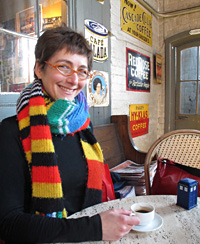This is the sort of instruction that strikes fear in the heart of many knitters.
Increase or decrease so many sts evenly across the row.
We ran into a terrific example last night in a Norah Gaughan pattern... On a row of 113 sts, decrease 33 stitches evenly across.
Now I do understand why these instructions are the way they are. In a multi-size pattern, it's a lot of fiddling for the designer to write up the detailed instructions on how to space out the decreases. And it takes up a lot of space in a printed pattern.
After all, this Norah Gaughan pattern has four or five sizes, each with a different number of stitches, and with a different number to decrease. It's much simpler - and takes up less room - if the specific details are left to the knitter. If the designer isn't specific about how to handle this, it typically means that the type of decrease (or indeed, increase) and the positioning doesn't matter much for the final result. If it really matters, the designer will (should!) specify.
One of the most notorious examples of this is the final yoke increase in the February Lady Sweater. (No insult intended to the designer - she's done a great job with it overall.) But this is a doozy. You're you're dealing with a massive number of stitches and a rather extraordinary number of increases.....
Work 41 (38, 47, 41, 41, 38, 39) YOs spaced evenly between the 197 (207, 219, 239, 267, 291, 311) center stitches.
A helpful and smart knitter out there has created an online tool to help you calculate the spacing of the increases. And in the class that I teach about this pattern, I provide specific instructions for each of the sizes.
There's also a decrease calculator on the same site.
To complicate things, increasing and decreasing are handled differently, and there are a couple of different ways of calculating the increase pattern depending on which increase you use.
I like M1 - either the EZ backwards loop method or the lifted bar method or - since you're creating a stitch out of nothing and it makes the math easier. (Check out this page for a terrific summary and demo of all the key increases. EZ backwards loop is M1A and M1T, and lifted bar is M1R and M1L. You can choose one and stick with it for most purposes - the differences are pretty small between the A/T and the R/L versions.)
I also use this example in my Pattern Reading class. Coincidentally, there's a session coming up next week, at Lettuce Knit... Click here for more info.
Subscribe to:
Post Comments (Atom)






1 comment:
What an amazing online find! I love all you computer/ math geeks who knit.
Post a Comment